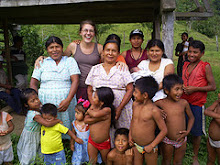
The small community of Nudobidti, which resides in the protected Palo Seco Forest Reserve, is nestled in the mountains between the Caribbean Coast and the River Changuinola. The climate is very much so the climate of a rain forest with moist rainy breeze, mud for ¨roads¨, every tropical disease known to man (such as Leshmaniasis, Dengue Fever and Malaria to name a few), and glowing green lushness as far as the eye can see. Coffee, cacao, root vegetables, bananas, plantain, and pifa thrive here.The indigenous Ngäbe-Bugle culture has a history in Panama that started long before pale skinned Spaniards came crashing on the shores of Central America. Nudobidti is a pure Ngabe village (except for the one white girl from Libertyville, Illinois that can be found roaming among them). Historically the Ngäbes are a hunter-gatherer society, which makes appropriate agricultural cultivation difficult. Generally their diet consists of bananas and pifa, which are crops that requires almost no maintenance whatsoever. With the pressure of the developing world and increased tourism growing up around them, their efforts to stay in par with the market demand and modernization is a constant struggle for their reserved and tranquilo ways. The neighboring town of Valle de Risco has a brand new school that was built last year and is a huge hope for the youth who speak mostly Spanish and want the opportunity to obtain something that their parents never had - a middle school education. Most adults are illiterate cacao farmers who know very little Spanish, a huge hindrance as many desire work outside the community as production levels have plummeted in the last generation and subsistence farming is something that few to none accomplished.Currently a multi-national company has moved into the area and plans are underway to do a huge hydro electrical dam project in the Rio Changuinola which will supply electricity from Costa Rica to Colombia (the communities it will be directly effecting won´t get to reap those same benefits though). As mentioned before, this community resides in a nationally protected forest, but the government has been paid to close their eyes while plans are being made to relocate entire communities, add to the degradation of the peoples native culture and ultimately endanger the fragile rain forest ecosystem. And so another classic story of a big business taking advantage of undereducated underprivileged people (and coincidentally enough, indigenous as well) in the name of progress.For the most part, the women of Nudobidti wear modern clothing, unlike their more traditional cousins in the Comarca Ngäbe-Bugle who exclusively wear naguas, the Ngäbe traditional dress. Naguas are decorated with colorful zig-zag designs which mimic the markings of venomous snakes and are meant to represent power. Some women also file their front teeth to a serrated edge for the same aesthetic purposes. Generally an entire extended family live together in one single house, including the grandparents, their children, their children's´children and then usually some random cousins. In the case of my host family, at one point I counted 24 people living with us, including myself, the majority sleeping in one single room. The houses are made of wood and are stilted, capped with a mess of penca (thatched palm). Basically, they look like little ewak huts. Women share children rearing responsibilities as well as house maintenance and food gathering. Living is basically communal in every sense.But the people are happy. You can find them fishing the river with nets, playing volleyball, echar-ing cuentas in town, where on a lucky day they have ice in a cooler over Coca Cola in the glass bottle at the store in town. (I say ¨town¨which is Valle de Risco. Imagine Valle de Risco as New York City and Nudobidti as say, Albany)
